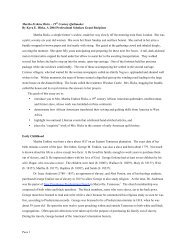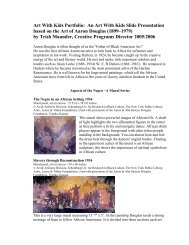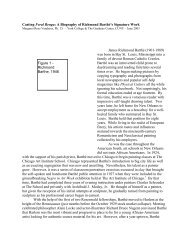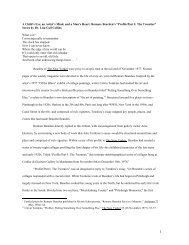Cuesta Benberry - The Anyone Can Fly Foundation, Inc.
Cuesta Benberry - The Anyone Can Fly Foundation, Inc.
Cuesta Benberry - The Anyone Can Fly Foundation, Inc.
Create successful ePaper yourself
Turn your PDF publications into a flip-book with our unique Google optimized e-Paper software.
CUESTA: Right. Right. Because that was a feather in their cap. Those pieces are justwonderful. So I’m not saying that in some instances the mistress may have taught theslave needle worker how to make various quilts, but in other instances not.You know, another thing I found when I went to Baltimore I found that in the census…this is during slavery time, that in the Baltimore census, as they listed the residents inthe back of the census they listed the free blacks in Baltimore. And so that was really agreat information, because those free blacks … <strong>The</strong>re were schools that they attended.You had to pay. So that meant that those free blacks who sent their children to theseschools, and they were not public schools, they were private schools, but they werethere. And one of the things they taught, … and the Headmaster was usually a man…and all of this can be documented and confirmed, because the records are not only therein Baltimore they’re in the Smithsonian, and I was just so elated when I found this out.Quilt making. Quilt making was a part of the curriculum.So those girls, and they came from all over. <strong>The</strong>y didn’t just come from Baltimore to goto those… <strong>The</strong>y called them Academies, Some from even here. Free Blacks. I got thelist of student for a year and it told where they lived originally and they’d been sent tolive. And they had more than one. It just grows. <strong>The</strong>re’s so much to this. In Baltimore,there was a nunnery of black nuns. I met one of the nuns here in St. Louis and had asmall display of quilts and she was telling me about in 1820 in Baltimore they madequilts. In almost all nunneries they’d teach fine needlework, at least they did back then.Here’s another young woman. Up in New York. She just got her Doctorate. Myra BrownGreen. She was so fascinated with that when I told her. She’s following it up. And she’salready made visits to the mother house there in Baltimore. It’s much reduced, but it’sstill in existence. And they have the records. All of these venues where African-Americans, even as far back as slavery, had access, in various ways to learn to makequilts. It’s so marvelous. I’m so happy that these younger people. Younger scholars aretaking it and go. It’s wonderful.Section II – African American QuiltsFAITH: <strong>Can</strong> we determine by focusing on the many quilting techniques - traditional,crazy quilt, strip quilt, so-called improvisational and art quilt – what has been our [theAfrican American's] dynamic contribution, our inspired innovation to the history anddevelopment of quilt making?CUESTA: I think the contribution has been so varied because, like you brought thistoday, this is something. And this can be developed.FAITH: That’s why it was important that you opened the door for this history. Becauseyou can’t know until you get the history.CUESTA: Right. Right. And until you can realize the scope of the history. And howmany areas are affected. I think that those improvisational, utilitarian quilts…page 8






